Outdoor Recreation and Restoring Injured Resources
Use of the coastal environment for outdoor recreation is an important part of the value of marine resources. Following pollution incidents such as oil or chemical spills, activities like swimming, fishing, and boating can be adversely impacted. In its mission to safeguard the benefits of oceans and coasts on behalf of the public, NOAA evaluates the impacts to recreation from spill incidents and undertakes restoration actions to compensate for public losses.
If there is a futuristic image of the perfect beach experience, it may be the giant indoor Ocean Dome in Southern Japan. The waves roll in with perfect consistency, the sun always shines but never burns, and a volcano on the horizon erupts every hour for predictable, but dramatic, effect. The cost of admission to the Dome is about 50 U.S. dollars.
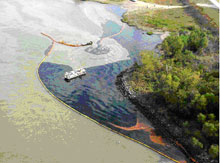
The accidental release of oil in coastal waters not only affects natural resources, but can also make an environment unavailable for fishing, boating, and other recreational activities.
U.S. beaches may not be engineered for the pleasures of leisure recreation, but at many popular destinations throughout the U.S., the typical beach experience depends on human intervention in ways both obvious and hidden. A wide variety of protection and restoration efforts are undertaken on behalf of the 60 million Americans who together spend over 800 million days at the beach every year. The effort would seem to be worth it – while fees at most U.S. beaches are well below $50, the value of a day at the beach is often much higher than what people actually pay.
This article looks at an important aspect of ocean and coastal management – the assessment of impacts from oil or chemical spills in the marine environment and restoration of the benefits of marine recreation activities. NOAA is a trustee of U.S. coastal resources, and trusteeship means more than protecting ecosystems on behalf of their natural inhabitants. It is one of the missions of NOAA to safeguard public use of the coast for swimming, surfing, fishing, bird watching, boating, and other types of recreational enjoyment.
Recognizing the Value of Recreation: Background
Although laws protecting the use of marine waters for navigation date back centuries, protections governing recreational activities are more recent. The Clean Water Act in the early 1970s first addressed the issue of compensation for impacts to recreational activities following oil or chemical spills. The federal Superfund law and the Oil Pollution Act further expanded the use of restoration projects to enhance marine recreation and compensate for spill-related losses. These and other laws recognize the value of natural resources in providing recreational enjoyment. They also recognize that simply cleaning up an affected environment may not be a sufficient response if a pollution event has disrupted recreational activities over a period of time.

We enjoy a wide range of recreational activities, such as a game of volleyball at the beach, often without thinking about what it is “worth” to be able to enjoy these activities.
Today, the study of recreational value is an important aspect of spill response throughout U.S. coastal waters. Measuring the human impact of pollution events, placing a value on the losses, and identifying ways to compensate the public is one of the more complicated, challenging, but ultimately rewarding, endeavors that environmental agencies are called upon to undertake.
Recreation Impacts in Days and Dollars
A major oil spill is a rare event, but even a moderate spill that does not make the national news can disrupt the seaside activities of local residents and visitors for many months. In many coastal locations, especially in large rivers near the coast, industrial sites can also be associated with chemical contamination that disrupts area fishing, swimming, and other water-based activities. On occasion, advisories or closures are issued for certain recreational activities to minimize potential hazards.
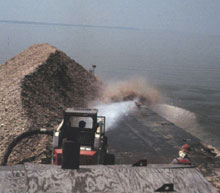
The enhancement or creation of oyster reefs can compensate for the loss of recreational shellfishing opportunities during an oil spill. Here, farm-raised oysters are added to reef habitat in the Chesapeake Bay. Click image for larger view.
Effective and rapid cleanup is generally the first priority of agencies involved with these localized pollution incidents. Agencies are also concerned with impacts that may occur before and during the cleanup, including the loss of recreational enjoyment. In response to pollution, people might spend fewer days recreating or they might travel to alternative locations. Some people may continue to use a site despite the degraded conditions. To provide compensation for these impacts, NOAA and other agencies must first determine the types of activities affected and the extent of those effects.
How Many Days Were Lost?
Impacts to recreation are measured in recreation days. For example, if 1,000 people typically use a particular beach each day, then a one-week closure of the beach means a loss of 7,000 beach days. Often, the use of a beach declines due to a pollution incident even without a closure, and in these cases the decline in activity is more difficult to measure. The measurement of “lost recreation days” due to an incident often relies on attendance records from recreation sites like beaches and boat ramps. Sometimes, the number of people using the shoreline is counted on the ground or from the air. Information of this kind is then combined with data from NOAA’s National Weather Service to account for the effects of temperature, sun, wind, and rain on marine recreational activities.
Some examples of impacts to recreational use include several relatively small oil spills over the past several years. In 2002, a spill in Charleston Harbor resulted in the loss of an estimated 4,232 recreational shrimping days. A spill in the Chesapeake Bay led to a decline of 6,352 boating days in 2000, and a spill on the Delaware River resulted in a loss of 15,024 fishing days in 2005. A major incident can have more dramatic effects, like a 416,000-gallon oil spill in Southern California in 1990 that resulted in the loss of 618,000 days at the beach.
What is a Recreation Day Worth?
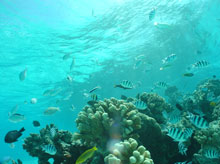
The total value of recreational activities associated with Hawaii’s coral reefs has been estimated at $133 million per year. Click image for larger view.
An important step in measuring an incident’s impact on recreation involves the calculation of a monetary value. It is relatively straightforward to estimate the number of recreation days affected, but what are all those recreation days worth? In 1947, the National Park Service posed this question to an economist named Harold Hotelling at Columbia University. To value days spent at a national park, he suggested collecting information on how far people travel to get there. By viewing the cost of travel as a price and the number of recreation days as demand, the value of each day can be found using standard economic methods. The value was defined as the amount of money someone would have to be paid to give up their day at the park.
Today, NOAA applies the same basic approach to estimate recreational losses following a pollution incident where recreation has been affected. With the help of computers, a deceptively simple idea has evolved into sophisticated mathematical models. First, data are collected on the characteristics of recreation sites and how often people visit them. A computer model then analyzes what people like most about the recreational options available to them, and predicts where people might go for outdoor recreation when avoiding a site affected by a spill. The computer model also estimates the value of the recreation days lost at the affected site.
Estimates of value depend on many factors, including the type of activity, the attractiveness of a particular site, and the availability of nearby alternative sites. The value of a day spent recreational shrimping in Charleston was found to be $25.24. A Massachusetts study estimated the value of a lost beach day at $40.36, and in the same study, a lost boating day, including activities like sailing and boat-based fishing, was valued at $70.25. A detailed example of how a model of recreation days works is available online as part of NOAA’s Southern California Beach Valuation Project.
Compensating the Public Using Resource Enhancements
The objective in estimating the value of lost recreation days is to identify restoration projects that will compensate the public for recreational losses. The funding for these projects is provided by the companies responsible for an incident. Compensation can be assured if funding is provided in the amount of the loss and if projects are selected that produce benefits greater than their cost.
Creating Compensatory Projects
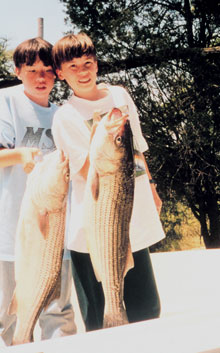
Recreational fishing is a popular activity in many coastal areas. If an oil spill or chemical release impacts fishing, NOAA may calculate the number of lost fishing days to help determine the required amount of resource restoration.
To ensure that the people most affected by an incident are appropriately compensated, projects are selected that have a close connection to the recreational activities impacted. For example, an area of the Chesapeake Bay commonly used by kayakers was impacted by an oil spill in April, 2000. A compensatory project was selected that would create a “paddle trail” for kayakers. Paddle trails are popular in many coastal areas and they guide kayakers and canoeists to sites of interest and often allow overnight camping along the way.
Restoring Fishing after an Incident
Fishing is a popular sport in many coastal areas, and recreational fishing in the U.S. includes an estimated 80 million saltwater fishing days each year. In consultation with local residents and resource agencies, NOAA implements a variety of projects to enhance fishing after a contamination incident. These projects may include the construction of fishing piers, the enhancement of public parks to allow more access for anglers, or acquiring for public use areas that might otherwise undergo private development.
Often the best projects are those that improve fishing and also enhance natural resources. For example, the construction of fish ladders or removal of dams can allow ocean-dwelling fish that spawn in streams to reach a wider area and increase in number. This restores a more natural balance to the ecosystem and increases fishing opportunities.
Beach Restoration
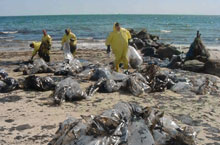
While cleanup workers are responding to a spill, area residents cannot use a beach for swimming, fishing, or other recreational activities. Future enhancements to the beach will provide compensation for the lost recreation days.
For beachgoers affected by a pollution event, restoration options include beach nourishment projects that supply sand to eroding beaches. Erosion of beaches can occur naturally, or can be caused by residential and commercial development along a beach. Nourishment projects maintain the width of a beach so that popular seaside areas can continue to support high levels of activity.
In many areas, natural dunes can erode away, contributing to beach erosion and detracting from a beach’s scenic beauty. The planting of dune grasses can help prevent dune erosion and construction of boardwalks or pedestrian overpasses can draw damaging foot traffic away from dunes. These projects add value to beach days and directly increase the number of beach days by allowing the beach to support additional visitors for years to come.
Conclusion
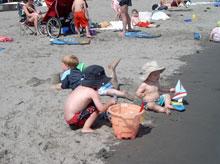
Children enjoying a beach in Rhode Island.
While prevention is always the primary concern, unintended spills can make popular coastal resources temporarily unavailable for recreation. One of the goals of resource stewardship is to replace the recreational opportunities that were lost. So far, no one in the U.S. has suggested following the example of the Ocean Dome and creating a whole new beach; however, creative human intervention can help people to enjoy what nature has provided.
The understanding of the value of natural amenities for outdoor recreation and the development of ways to ensure that impacted communities are appropriately compensated has benefited from many decades of research and from effective cooperation among agencies and industry. NOAA continues to be committed to making a significant contribution in this important endeavor.
Works Consulted
Leeworthy, V. & Wiley, P. (2001). Current Participation Patterns in Marine Recreation. Retrieved July 27, 2006, from http://marineeconomics.noaa.gov/NSRE/NSRE_V1-6_May.pdf
NOAA. (2005). Economic Statistics for NOAA. Fourth Edition, May 2005. Retrieved July 28, 2006, from http://www.publicaffairs.noaa.gov/pdf/
economic-statistics2005.pdf
NOAA. (2005). Fisheries of the United States, 2004. Elizabeth Pritchard, ed. November 2005. Retrieved July 28, 2006, from http://www.st.nmfs.gov/st1/fus/fus04/index.html
Rosenberger, R. & Loomis, J. (2001). Benefit transfer of outdoor recreation use values: A technical document supporting the Forest Service Strategic Plan (2000 revision), U.S. Department of Agriculture, Forest Service, Fort Collins, Colorado.
